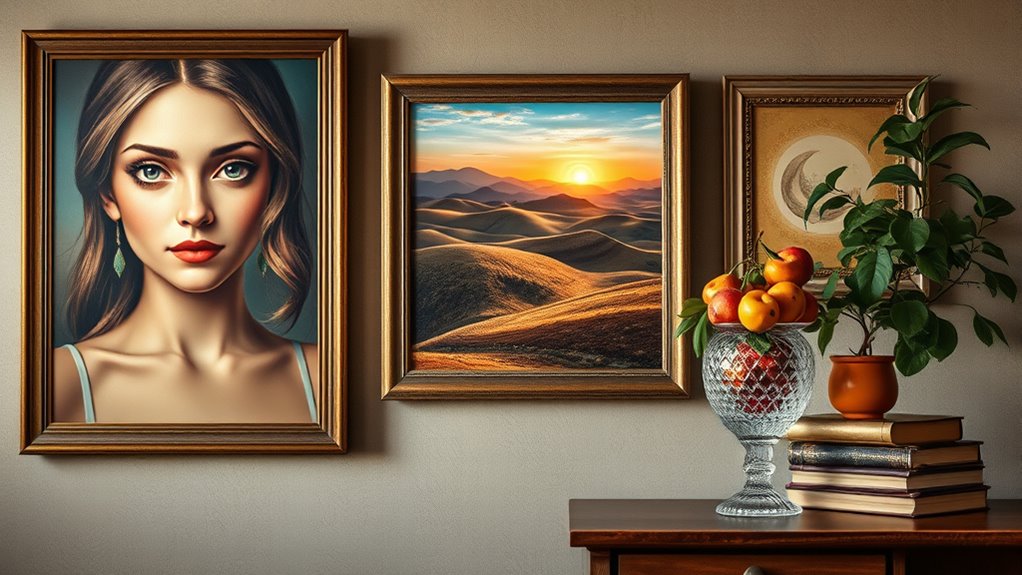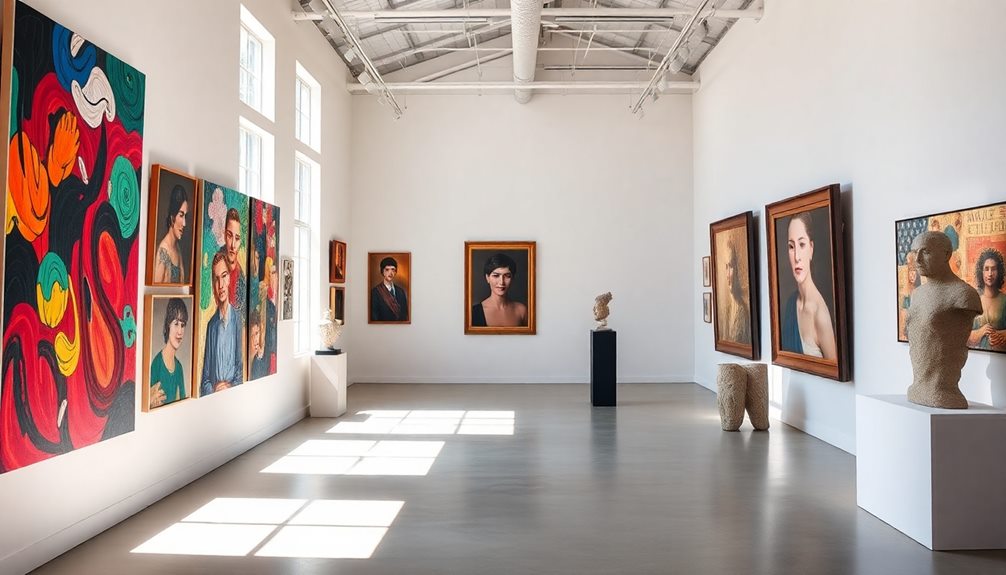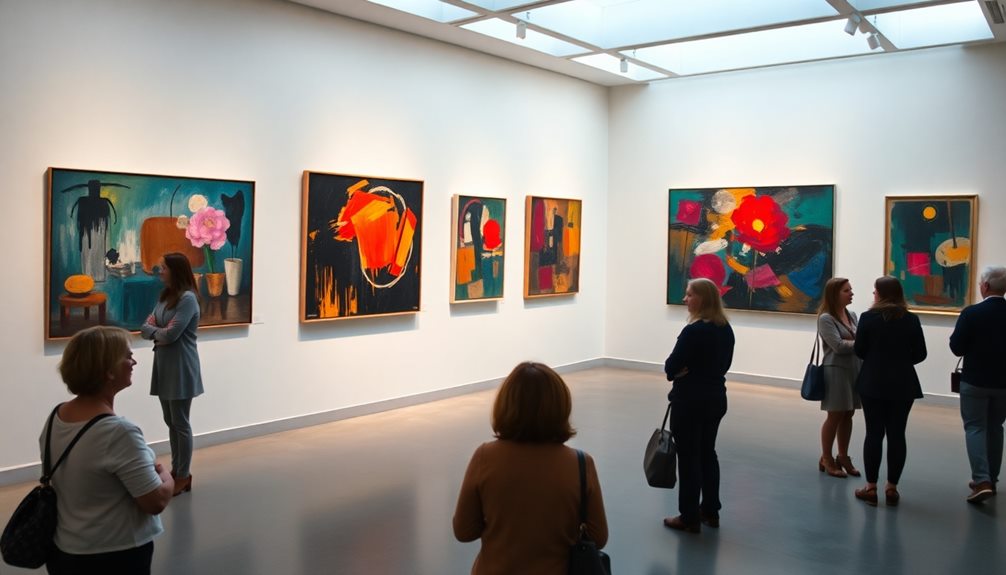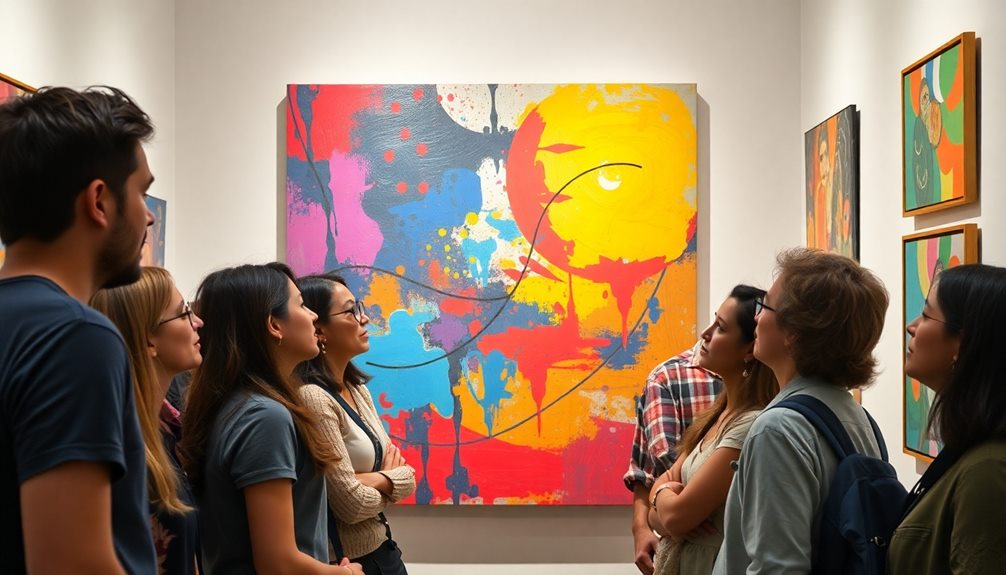A guide to art genres helps you understand how different styles like portraits, landscapes, and still lifes communicate ideas and emotions. Portraits reveal personality and mood, landscapes show nature and cultural stories, and still lifes focus on everyday objects and symbolism. Recognizing these differences builds your appreciation and interpretation skills. Each genre uses distinct visual languages and techniques, shaped by cultural influences. Exploring more will deepen your connection with the artworks themselves.
Key Takeaways
- Understanding different art genres reveals their unique goals, such as realism in portraits or emotion in abstract art.
- Recognizing genre distinctions enhances appreciation of an artwork’s purpose and cultural context.
- Art genres often blend, creating hybrid styles that expand artistic expression beyond traditional boundaries.
- Visual language and techniques, like brushwork or color, communicate each genre’s specific intent and mood.
- Knowledge of genre history and purpose deepens connection and interpretation of artworks across styles.

Ever wonder what sets apart one art genre from another? It’s a question that often stumps newcomers and seasoned art lovers alike. The truth is, each genre has its own language, its own way of expressing ideas, emotions, and stories. For example, abstract expressionism breaks away from traditional forms, emphasizing spontaneous, emotional gestures that convey raw feeling. Think of bold splashes of color and dynamic brushwork that aim to evoke an immediate visceral response. In contrast, Renaissance realism strives for precise, detailed depictions of the human form and the natural world, capturing the complexities of light, shadow, and anatomy with meticulous care. It’s a style rooted in scientific observation and technical mastery, designed to create an illusion of reality that draws you into a scene or portrait. Understanding these differences helps you appreciate the goals behind each genre: some seek to evoke emotion through abstraction, while others aim for a faithful, almost photographic representation.
As you explore these genres, you’ll notice that the boundaries are often fluid, with artists borrowing elements from different styles to craft unique works. For example, contemporary artists might combine the emotional intensity of abstract expressionism with the detailed realism of earlier periods, creating hybrids that challenge traditional classifications. But regardless of the style, what truly defines each genre is its purpose. Portraiture, for instance, isn’t just about capturing a person’s likeness; it’s about revealing personality, status, or mood. Landscapes serve as a window into nature or a specific place, often reflecting cultural values or personal memories. Still lifes focus on everyday objects, highlighting their forms, textures, and symbolism. Each genre offers a different lens through which you can see the world, and understanding their distinct characteristics enriches your viewing experience. Recognizing the distinctive features of each style can help you better interpret and appreciate the artist’s intent. Additionally, mastering the visual language used in each genre allows for a deeper connection to the artwork’s meaning and context. Exploring the cultural influences behind various genres can also deepen your understanding of their significance and evolution.
Furthermore, exploring the technical aspects of each genre reveals how artists utilize various methods to communicate their ideas more effectively. When you start to notice the techniques and themes within each genre, you’ll see how artists use color, composition, and brushwork to communicate their intentions. Abstract expressionism, for example, often employs large canvases with gestural strokes to express intense emotion, while Renaissance realism involves precise layering and glazing to achieve depth. Additionally, understanding color accuracy and its impact on visual fidelity can deepen your appreciation for how artists convey mood and realism within their chosen styles. Whether you’re admiring a swirling, energetic abstract piece or a carefully rendered portrait, you’re witnessing the artist’s efforts to connect with you through their style. Recognizing these differences not only deepens your appreciation but also enhances your ability to interpret what an artwork is trying to say. Ultimately, every genre has its own voice, and by understanding them, you’ll become a more attentive, insightful viewer.
Frequently Asked Questions
How Do I Start Exploring Different Art Genres as a Beginner?
To start exploring different art genres, you should first experiment with techniques for beginners like basic sketching, shading, and color mixing. Choose simple, affordable art supplies such as pencils, watercolors, and sketchpads to keep it manageable. Try creating small projects in various styles to see what excites you. Keep an open mind, practice regularly, and don’t be afraid to make mistakes—each piece helps you learn and discover your artistic preferences.
What Are the Key Elements That Define Each Art Genre?
Imagine you’re time-traveling to Picasso’s studio—each genre has its own vibe. You’ll notice that portraits focus on technique analysis of facial features, landscapes capture nature’s essence, and still lifes emphasize composition and thematic symbolism of objects. Recognizing these key elements helps you define each genre. By observing style, subject matter, and underlying themes, you can better appreciate and create across diverse art forms.
How Have Art Genres Evolved Over History?
You see that art genres have evolved considerably over history, driven by the evolution of artistic styles and historical influences. As societies changed, artists adapted their techniques and themes, blending traditions with new ideas. This ongoing evolution reflects cultural shifts, technological advances, and changing tastes. You can trace this journey from classical realism to modern abstract art, understanding how each era’s context shapes the genres you observe today.
Can Artists Combine Multiple Genres in a Single Work?
You might think combining genres dilutes an artwork’s meaning, but genre fusion actually enriches it. Yes, artists often create multi-genre artworks, blending portraits with landscapes or still lifes with abstract elements. This genre fusion allows for innovative storytelling and visual complexity, making your art more engaging. By mixing genres, you can explore new ideas and challenge traditional boundaries, resulting in dynamic, multi-dimensional pieces that captivate viewers.
What Are Some Famous Contemporary Artists in Each Genre?
You’ll find many famous contemporary artists who excel in each genre by using innovative mixed media and genre blending techniques. For portraits, check out Kehinde Wiley, known for vibrant, modern approaches. In landscapes, consider Olafur Eliasson, blending installation art with natural scenery. Still life artists like Takashi Murakami incorporate pop culture elements. These artists push boundaries, creating dynamic works that challenge traditional genre definitions through creative fusion.
Conclusion
Now that you’ve explored these art genres, you’re just beginning to understand their true power. Each piece holds secrets waiting to be uncovered—stories, emotions, truths beyond words. As you look closer, remember: the more you discover, the more questions arise. Art isn’t just about what you see; it’s about what it makes you feel and what it keeps hidden. The real journey starts now—are you ready to reveal the unseen?









